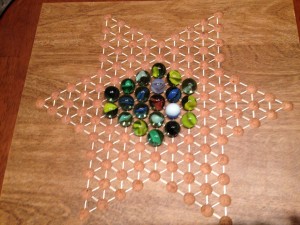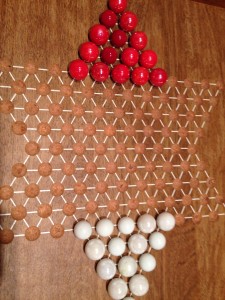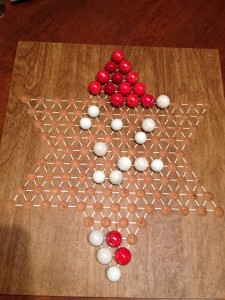Observe How Children Think
Sometimes grandparents ask me, “How can I tell what my grandchildren know, or are ready to learn? How do I know what games to buy them, or which toys?”
The only answer I can give is spend as much time as  you can with your grandchildren, and watch them. See what they do, how they solve problems, what they are good at and what they like to do with children their own age.
you can with your grandchildren, and watch them. See what they do, how they solve problems, what they are good at and what they like to do with children their own age.
That is what I was doing when I began playing Chinese Checkers with my granddaughter.
The wooden board with the star shaped design on it had fascinated her for months. She would pull it out of the bookcase, place it on the carpet and put cats-eye marbles into the round depressions so that they made designs. Then she would take all the marbles off the board, put them back in the wooden box where they were kept, and start over again. Sometimes this would keep her engaged for as long as an hour.
Shortly after she turned five, I brought out a set of unicolored marbles and showed her how to place them into each point of the star. We did that together for a few days, sometimes also making designs in the middle of the board. Then one day I asked her if she would like to learn to play Chinese Checkers.
In doing this, I was being a grandma, not a retired early childhood educator. Playing Chinese Checkers or other traditional board games requires logical thought, and many five year olds are still acquiring the cognitive skills needed for that process. In retrospect, introducing this game at this early age might have led to tears of frustration. Fortunately it didn’t.
Bean likes rules. After three or four sessions, she had such a good grasp of the rules she was able to explain them to her mother:
“You have to move your marbles from one point of the star to another one. You have to stay on the lines, and you can only move one space at a time unless there is a marble in front of you If there is, you can jump over it. If there is another one after you land, you can jump over that one too.” “Oh, and once you take your fingers off a marble, you’re DONE MOVING.” (This last bit with a loud voice.)
At that point, she turned to me with a big smile. “Right, Grandma?”
Children begin to understand games with rules somewhere between ages five and seven. At first they believe that the rules are unchangeable, simply part of the way the world works. Once they understand that people make the rules, usually around age 7 or 8, they also begin to understand that those rules can be changed.
The first few times that we played together, I set up my marbles to encourage my young opponent to hop across the board by jumping one, two, three, or even four marbles that were set out one space apart. She enjoyed the jumping toward the goal, but just as often would jump sideways, or even backwards. At first I asked her why, and sometimes teased her that she was going backwards.
Her response was to put out six blue marbles in random places on the board. “Let’s say that we can’t jump the blue marbles, Grandma. We have to go around them. Ok?”
At first I thought she was changing the rules, and wondered at that, since she seemed too young to be doing so. However, I soon realized that the point of the blue marbles was to extend the game. Winning the game in the traditional way, by moving her red marbles into the star point on my side of the board, was not the main object for her, even though I had explained it clearly, and she had explained it to her mother. Instead, playing the game for as long as possible was her actual goal.
Enjoy the Journey
After that I didn’t question her moves again, and just enjoyed the clickety clack of the marbles, and the wonderful conversations that took place while we played. I decided that I’d introduced strategy too early, and should just forget about that part of the game for a while. We did eventually get all our marbles into the target corners, but the route was often very circuitous.
But then one day she pulled out the board and the box of marbles as soon as she arrived at my house, and asked me to play with her. I could see from the outset that she had decided to play the game straight this time. She moved only one red marble at a time out of its starting corner, and continued to move just that one marble until it reached the furthest corner of the star, at which time she would take another marble out of the starting corner. Before long, my white marbles were spread out across the board, but most of her red ones were still in the original triangle. I had to wait my turn to move into the spaces as she vacated them one at a time.
Using her new strategy, Bean won that game by two moves.
The next day she went back to making designs with cats eye marbles.
I’m still not sure exactly what happened that day, and I suspect I should get used to being surprised by her five year old approach to game theory. But, hey, I like making designs with marbles too, so it’s all good.
For those grandparents who ask me what toys to buy or games to play with their grandchildren, all I can offer is this: Enjoy your time together; observe your grandchildren and learn what you can about them. But don’t be surprised if they don’t follow the developmental guidelines you read on Google or in parenting books. Every child is unique. And that’s the fun of being a grandparent. We don’t have to understand what’s going on in their heads . . . all we have to do is love them.
To receive my reflections each week, enter your email address above.
I love to read your comments; you may use the Reply box below to post one.
If you enjoyed this post, please share it on social media:
Share this post




Have you tried tic-tat-toe, (not sure if that name is correct), but
it uses a 3×3 grid and you put either 0 or 1,
and who ever gets 3 in a row or diagonal, wins.
For skilled players the winner is obvious
after 2 moves or so.
So with 2 skilled players,
it is always a draw, no one wins.
No I haven’t, Dennie, but you’re right – it’s probably a good game for a five to seven year old to learn. It might be easier to start with a version of it that has markers in the shape of 0 and X so that a very young child, who can’t write yet, can learn the concept.